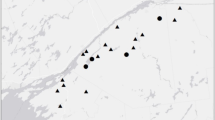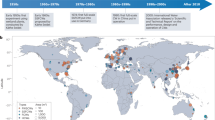Abstract
In a system with mercury contamination, there are trade-offs between beneficial functions of a wetland and environmental risk of methyl mercury (MeHg) production. This project used five wetland mesocosms with three different experimental designs to assess the potential for nutrient, sediment, and total mercury (THg) removal and MeHg production associated with a proposed a large-scale wetland system. The latter was suggested for the mouth of Steamboat Creek (Nevada, USA) at the confluence with the Truckee River. Steamboat Creek has been documented to have high mercury concentrations and is a major source of nutrients to the river. Mesocosms that had creek sediments as the base and creek water as inflows resulted in decreasing THg concentration by 72–82%. Average percent nitrogen and phosphorus and suspended solids removal were 43%, 30%, and 70%, respectively. Net MeHg production was observed during spring, summer, and fall months; however, in the winter, these mesocosms acted as a sink. One wetland mesocosm with sediments low in mercury and creek water showed similar trends. Mesocosms with creek sediments and water low in mercury were a source of MeHg year round, with outflow concentrations 10 to 200 times that in the inflow. Based on the developed data, the environmental risk of the proposed large-scale wetland would be an increase of methyl mercury concentration in creek water that reaches the Truckee River by as much as 20 to 75%. However, the wetland would also be a significant sink for nutrients, suspended solids, and total mercury, decreasing the amount of mercury available for methylation downstream.
Similar content being viewed by others
Literature cited
Bloom, N. S. 1989. Determination of picogram levels of methylmercury by aqueous phase ethylation followed by cryogenic gas chromatography with cold vapor atomic fluorescence detection. Canadian Journal of Fisheries and Aquatic Sciences 46:1131–1140.
Bloom, N. S., J. A. Colman, and L. Barber. 1997. Artifact formation of methyl mercury during aqueous distillation and alternative techniques for the extraction of methyl mercury from environmental samples. Fresenius’ Journal of Analytical Chemistry 358:371–377.
Bloom, N. S. and E. A. Crecelius. 1983. Determination of mercury in seawater at sub-nanogram per liter levels. Marine Chemistry 14:49–59.
Bloom, N. S. and W. F. Fitzgerald. 1988. Determination of volatile mercury species at the picogram level by low temperature gas chromatography with cold vapor atomic fluorescence detection. Analytica Chimica Acta 208:151–161.
Bloom, N. S. and E. J. Von der Geest. 1995. Matrix modification to improve the recovery of MMHg from clear water using distillation. Water Air and Soil Pollution 80:1319–1324.
Blum, M., M. S. Gustin, S. Swanson, and S. G. Donaldson. 2001. Mercury in water and sediment of Steamboat Creek. Nevada: implications for stream restoration. Journal of the American Water Resources Association 37:795–804.
Boeing, D. W. 2000. Ecological effects, transport, and fate of mercury: a general review. Chemosphere 40:1335–1351.
Branfireun, B. A., N. T. Roulet, C. A. Kelly, and J. W. M. Rudd. 1999. In situ sulfate stimulation of mercury methylation in a boreal peatland: Toward a link between acid rain and methylmercury contamination in remote environments. Global Biogeochemical Cycles 13:743–750.
Compeau, G. C. and R. Bartha. 1985. Sulfate-reducing bacteria: Principal methylators of mercury in anoxic estuarine sediment. Applied and Environmental Microbiology 50:498–502.
Craft, C. B. 1997. Dynamics of nitrogen and phosphorus retention during wetland ecosystem succession. Wetlands Ecology and Management 4:177–187.
Dumarey, R., E. Temmerman, T. Dams, and J. Hoste. 1985. The accuracy of vapor injection calibration method for determination of mercury by amalgamation/cold vapor atomic fluorescence spectrometry. Analytica Chimica Acta 208:337–340.
Gill, G. A. and K. W. Bruland. 1990. Mercury specification in surface freshwater systems in California and other areas. Environmental Science and Technology 24:1392–1400.
Gill, G. A., and W. F. Fitzgerald. 1987. Picomolar mercury measurements in seawater and other materials using stannous chloride reduction and two stage gold amalgamation with gas phase detection. Marine Chemistry 20:227–243.
Gilmour, C. C., G. S. Riedel, M. C. Ederington, J. T. Bell, J. M. Benoit, G. A. Gill, and M. C. Stordal. 1998. Methylmercury concentrations and production rates across a trophic gradient in the northern Everglades. Biogeochemistry 40:327–345.
Gustin, M. S., L. Saito, and M. Peacock. 2005. Anthropogenic impacts on mercury concentrations and δ15 N and δ13 C values in fish of the Truckee river watershed, Nevada, USA. Science of the Total Environment (in press).
Heiri, O., A. F. Lotter, and G. Lemcke. 2001. Loss of ignition as a method for estimating organic and carbonate content in sediments: reproducibility and comparability of results. Journal of Paleolimnology 25:101–110.
Horvat, M., L. Liang, and N. S. Bloom. 1993. Comaprison of distillation with other current isolation methods for the determination of methyl mercury compounds in low level environmental samples. Analytica Chimica Acta 282:153–168.
Kadlec, R. H. and R. L. Knight. 1996. Treatment Wetlands. Lewis Publishers, CRC, New York, NY, USA.
Keeler, G., G. Glinsorn, and N. Pirrone. 1995. Particulate mercury in the atmosphere: its significance, transport, transformation, and sources. Water Air and Soil Pollution 80:159–168.
Kelly, C. A., J. W. Rudd, R. A. Bodaly, N. P. Roulet, V. L. St. Louis, A. Heyes, T. R. Moore, S. Schiff, R. Aravena, K. J. Scott, B. Dyck, R. Harris, B. Warner, and G. Edwards. 1997. Increases in fluxes of greenhouse gases and methyl mercury following flooding of an experimental reservoir. Environmental Science and Technology 31:1334–1344.
King, J. K., S. M. Harmon, T. T. Fu, and J. B. Gladden. 2002. Mercury removal, methylmercury formation, and sulfate-reducing bacteria profiles in wetland mesocosms. Chemosphere 46:859–870.
King, J. K., J. E. Kostka, M. E. Frischer, and F. M. Saunders. 2000. Sulfate-reducing bacteria methylate mercury at variable rates in pure culture and in marine sediments. Applied and Environmental Microbiology 66:2430–2437.
King, J. K., J. E. Kostka, M. E. Frischer, F. M. Saunders, and R. A. Jahnke. 2001. A quantitative relationship that demonstrates mercury methylation rates in marine sediments are based on the community composition and activity of sulfate-reducing bacteria. Environmental Science and Technology 35:2491–2496.
Knowlton, M. F., C. Cuvellier, and J. R. Jones. 2002. Initial performance of a high capacity surface-flow treatment wetlands. Wetlands 22:522–527.
Liang, L., M. Horvat, and N. S. Bloom. 1994. An improved speciation method for mercury GC/CVAFS after aqueous phase ethylation and room temperature precollection. Talanta 41:371–379.
Lyons, W. D., D. M. Wayne, J. J. Warwick, and G. A. Doyle. 1998. The Hg geochemistry of a geothermal stream, Steamboat Creek, Nevada: Natural vs. anthropogenic influences. Environmental Geology 34:143–150.
Macalady, J. L., E. E. Mack, D. C. Nelson, and K. M. Scow. 2000. Sediment microbial community structure and mercury methylation in mercury-polluted Clear Lake, California. Applied and Environmental Microbiology 66:1479–1488.
Marvin-DiPasquale, M. C., J. L. Agee, R. M. Bouse, and B. E. Jaffe. 2003. Microbial cycling of mercury in contaminated pelagic and wetland sediments of San Pablo Bay, California. Environmental Geology 43:260–267.
Matilainen, T. 1995. Involvement of bacteria in methylmercury formation in anaerobic lake waters. Water Air and Soil Pollution 80:757–764.
Matilainen, T. and M. Verta. 1995. Mercury methylation and demethylation waters. Canadian Journal of Fisheries and Aquatic Sciences 52:1597–1608.
Morel, F. M. M., A. M. L. Kraepiel, and M. Amyot. 1998. The chemical cycle and bioaccumulation of mercury. Annual Review of Ecology and Systematics 29:543–566.
Reed, S. C. and D. S. Brown. 1992. Constructed wetlands design: the first generation. Water Environment Research 64:776–781.
Rudd, J. W. M. 1995. Sources of methylmercury to freshwater ecosystems: a review. Water Air and Soil Pollution 80:697–713.
Sladek, C., M. S. Gustin, C. S. Kim, and H. Biester. 2002. Application of three methods for determining mercury speciation in mine waste. Geochemistry: Exploration Environment Analysis 2:369–376.
Spieles, D. J. and W. J. Mitsch. 2000. The effects of season and hydrologic and chemical loading on nitrate retention in constructed wetlands: a comparison of low- and high-nutrient riverine systems. Ecological Engineering 14:77–91.
Spurkland, L. E. 2001. Watershed restoration and water quality improvements along Steamboat Creek using constructed wetlands. M.Sc. Thesis. University of Nevada, Reno, NV, USA.
Stamenkovic, J., M. S. Gustin, M. C. Marvin-DiPasquale, B. A. Thomas, and J. L. Agee. 2004. Distribution of total and methyl mercury in sediments along Steamboat Creek (Nevada, USA). Science of the Total Environment 322:167–177.
Steffan, R. J., E. T. Korthals, and M. R. Winfrey. 1988. Effects of acidification on mercury methylation, demethylation, and volatilization in sediments from an acid-susceptible lake. Applied and Environmental Microbiology 54:2003–2009.
St. Louis, V. L., J. M. W. Rudd, C. A. Kelly, K. G. Beaty, N. S. Bloom, and R. J. Flett. 1994. The importance of wetlands as sources of methyl mercury to boreal forest ecosystems. Canadian Journal of Fisheries and Aquatic Sciences 51:1065–1076.
St. Louis, V., J. W. M. Rudd, C. A. Kelly, K. G. Beaty, R. J. Flett, and N. T. Roulet. 1996. Production and loss of methylmercury and loss of total mercury from boreal forest catchments containing different types of wetlands. Environmental Science and Technology 30:2719–2729.
Stober, Q. J., R. D. Jones, and D. J. Scheidt. 1995. Ultra trace mercury in the Everglades ecosystem, a multi-media canal pilot study. Water Air and Soil Pollution 80:991–1001.
Thomas, B. 2003. Characterization of total and methyl mercury in Streamboat Creek, Nevada and implications for the Truckee River. M.Sc. Thesis. University of Nevada, Reno, NV, USA.
Ullrich, S. M., T. W. Tanton, and S. A. Abdrashitova. 2001. Mercury in the aquatic environment: a review of factors affecting methylation. Critical Reviews in Environmental Science and Technology 31:241–293.
U. S. Army Corps of Engineers. 2001. Section 206 Preliminary Restoration Plan, Steamboat Creek. Final Report. U.S. Army Corps of Engineers, Sacramento District. Sacramento, CA, USA. Additional materials available online at http://www.spk.usace.army. mil/projects/civil/SteamboatCreek/index.html
Verta, M., T. Matilainen, P. Porvari, M. Niemi, A. Uusi-Rauva, and N. S. Bloom. 1994. Methylmercury sources in boreal lake ecosystems. p. 119–136. In C. J. Watras and J. W. Huckabee (eds.) Mercury Pollution: Integration and Synthesis. Lewis Publishers, Boca Raton, FL, USA.
Zillioux, E. J., D. B. Porcella, and J. M. Benoit. 1993. Mercury cycling and effects in freshwater wetland ecosystems. Environmental Toxicology and Chemistry 12:2245–2264.
Author information
Authors and Affiliations
Rights and permissions
About this article
Cite this article
Stamenkovic, J., Gustin, M.S. & Dennett, K.E. Net methyl mercury production versus water quality improvement in constructed wetlands: Trade-offs in pollution control. Wetlands 25, 748–757 (2005). https://doi.org/10.1672/0277-5212(2005)025[0748:NMMPVW]2.0.CO;2
Received:
Revised:
Accepted:
Issue Date:
DOI: https://doi.org/10.1672/0277-5212(2005)025[0748:NMMPVW]2.0.CO;2




